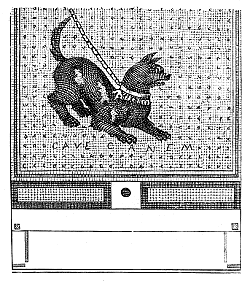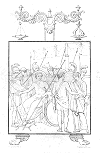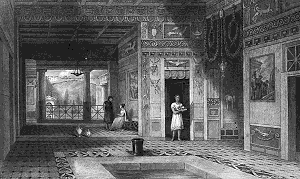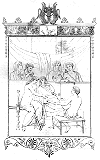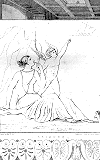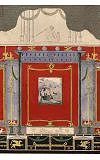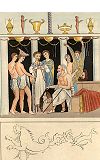Chapter VIII - House of the Tragic poet |
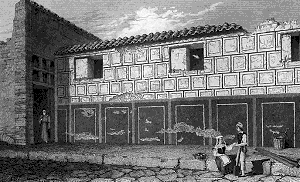
Plate 38 - CommentaryDiscovered at the close of the year 1824. |
On the pier left of the door was written in red characters
M. HOLCONIVM. AED
C. GAVINIVM
This inscription, unfortunately, gives no information with regard to the proprietor of the house. The three following are scratched with a nail on the outer wall ; and the first, which is reversed in the original, seems to offer a puzzle to the passenger :
 |
The following letters are on the pier at the angle of a house forming, with this of the poet, the entrance of the vicus of the fullonicae.
 |
A learned Neapolitan has translated the Etruscan part of this inscription. He says it signifies, «You shall hear a poem of Numerius». To one unskilled in the language, it appears to be the name of an owner of the house, and might be M. P. Cepius. The doors turned upon pivots in two umbilici of bronze fixed into a marble threshold, the outer part of which rose about an inch above the rest. This, with two door-posts of wood, also fixed in holes in the marble, served to maintain the door in its position when shut.
|
On entering, the first object is a black dog spotted
with white, represented on the pavement in mosaic,
collared and chained, and in the attitude of barking.
The collar is of red leather. Below the animal is
inscribed, in very legible characters, CAVE CANEM, a
sentence, probably, not uncommonly placed at the
entrance of Roman houses, as we learn from a passage of
Petronius Arbiter : «Canis ingens catena vinctus,
non longe ab ostiarii cella in pariete erat pictus,
superque quadrata littera scriptum CAVE, CAVE
CANEM». |
The passage entry, or vestibule, is about six feet wide,
and nearly thirty in length ; and a curtain, or door, may
have been placed at the entry of the atrium. Statues
could not have existed in this vestibule, as they are said by
Saint Augustine, De Civ. Dei (IV, 8), to have done in
Roman houses. He says that three gods guarded the doors :
«Forculum foribus, Cardeam cardini, Limentinum
limini». These protectors of doors, hinges, and
thresholds might have been painted on the wall ; but, as yet,
no traces of them have been observed in the habitations of
Pompeii.
The atrium is about twenty-eight feet in length by
twenty, with its impluvium near the centre, under
which was a cistern whence the water might be drawn through a
fluted hollow cylinder of marble.
The floor is prettily paved with white tesserae,
spotted, at intervals, with black ; and, round the
impluvium, is a well-executed interlaced pattern, also
in black.
The following inscription on a slab of marble is said to have
been found in this atrium on the 5th of March, in the
year 1825. There seems to have been nothing to afford room
for a conjecture as to how it came there. It might, perhaps,
have been thrown into an excavation which the ancients
themselves seem to have made in this spot, or have fallen
from an upper wall.
L. CAECILIVS . FELIX
Q. LOLLIVS. FELIX
Q. ARRIVS. HIERONI
sic pro minist. MINIT. AVGVST
EX DD JVSSV
M. POMPONI. MARCELI.
VALERI FLACCI
D.V.J.D
A. PERENNI MERVLINI
L. OBELLI LVCRETIANI
D.V.V. A. S. P.P.
C. CAESARE L. PAVLLO
COSS
Perhaps, as the inscription does not seem to allude
clearly to the owner of the house, its chief merit may
consist in having been engraved in the first year after the
birth of our Saviour, about 753 years after the building of
Rome, when Caius Julius Coesar and Lucius Aemilius Paullus
were consuls.
On the left, on quitting the vestibule, yet remain the legs
and part of the body of a beautiful Venus painted in tempra,
or distemper, upon the wall. The colouring is quite that of
Titian, and the attitude not unlike that of the Venus dei
Medici. One hand is held up over the head, and supports a
light, undulating blue drapery. On the ground is a dove and
the myrtle branch, the emblems of the goddess. More of this
exquisite painting might, possibly, have been preserved by
greater tare in excavating, though the plaster, in many
parts, adhered but slightly to the wall.
Still proceeding to the left, the first small chamber is
painted of a yellow colour with black pilasters ; and, from
this, a narrow stair-case ascended to the upper story of the
house.
That an upper floor was usual at Pompeii may be proved by the
frequent staircases, and the remains of the painted walls of
the upper rooms, above the holes for placing the beams over
the lower apartments ; while the slight construction of these
walls renders very improbable the existence of any still
superior chambers, though Juvenal remarks, Sat. III., that
the houses very commonly fell with a tremendous crash. During
the excavation, the fragments of the mosaic pavement of the
upper floor, with a head of Bacchus, were discovered in this
house ; and, what is curious, considering the evident
indications of a previous examination of the place, probably
not long after the fatal eruption, several articles of value
were found, which appeared to have fallen from above.
This circumstance gave rise to the idea that the house must
have belonged to a jeweller, or rich goldsmith, and nothing
yet observed tends materially to invalidate the opinion ;
for, except the mosaic, there is nothing peculiarly devoted
either to poetry or tragedy in the mansion. All the other
houses of Pompeii were decorated with paintings of
mythological or heroic subjects, because, in fact, the poets
and painters seldom sung or painted any other.
The position of the house must have been easily ascertained
by the survivors after the catastrophe, from its proximity to
the thermae, the arches of which, as well as the dome
of the piscina, resisted the weight of the volcanic
matter ; and the riches of the proprietor were naturaily the
incentives to the research which followed, and of which the
vestiges were so apparent.
The unfortunate proprietors were, probably, among the victims
of the eruption, for skulls, or the fragments of them, were
found on the spot ; and a variety of trinkets were considered
as the indications of the toilet, or dressing-box, of the
lady of the house.
Among these were remarked two necklaces of gold ; a twisted
gold cord ; four bracelets, one weighing seven ounces, and
formed into serpents ; a child's necklace ; two small
bracelets ; four earrings, and an engraved stone mounted in a
large ring. Two coins, also of gold, were found.
Forty-two silver coins, a bracciere for fire, and a variety
of utensils of bronze and earthenware, formed part of the
riches of this house, after the ancient excavators had
already searched the place.
In one of the adjoining houses of refreshment, the skeleton
of an unhappy proprietor was also discovered. He had, in
vain, sought shelter under a staircase of stone, where he was
probably suffocated. His treasure was found near, and
consisted of rings of gold, with earrings of the same metal,
together with about 140 coins of brass and silver.
It has usually been agreed, that, in Roman houses, the lower
or ground floor was appropriated to the master of the house,
and to the more magnificent apartments, while the upper was
occupied by the servants. In a Greek house, as we learn from
the celebrated oration of Lysias, they were changeable ; and,
possibly, they were so in the habitations of Pompeii, which
are, with difficulty, reducible exactly to the rules given by
Vitruvius for the houses of either people.
Euphiletes, the client of Lysias the celebrated orator, had a
house consisting of two floors ; the lower usually occupied
by the males of the family, and the upper serving as a
gynecaeum, or apartment for the women and children. On some
occasion, for the convenience of nursing, the uses of the
apartments were changed ; and Sostratus, a friend of
Euphiletes, is mentioned particularly as having gone up
stairs even to supper, the nurse and child being always
below. The wife slept, at night, with the husband above. One
night, the nurse, having concealed in a lower room the lover
of the wife, pinched the child till its cries were heard by
the parents. Euphiletes, surprised at the inhumanity of his
wife, who at first seemed unwilling to attend to the child,
ordered her to get up and go to its assistance ; but,
observing that, as she went out, she cautiously turned the
key and locked him into his room, and having, on former
occasions, heard the street-door open while she was absent,
he suspected there might be some mystery in the business,
though he had been always told that the noise was occasioned
by his wife going to a neighbour's for a light, as the lamp
below had gone out, and the child wanted help. Having found
means to open his door, Euphiletes went out, unperceived, in
search of Sostratus, his friend, leaving the street-door
ajar, that he might re-enter at pleasure to detect the
culprits, who were, accordingly, surprised by the breaking
open of their chamber.
This description of facts seems such as might have taken
place in a house like this at Pompeii ; and, from the absence
of all privacy during the day, it seems scarcely credible
that the apartment of the females could have been on the
ground floor in the house of the Tragic Poet, or, perhaps,
any other in the city. When the porta antica, or great
door, was opened, every one from the street could see nearly
all that passed, except in the triclinium of Leda,
which was, in its turn, completely exposed from the other
street on opening the porta postica ; so that the
females of the family could have had no retreat except, like
Penelope, they inhabited the upper rooms of the house.
It is very probable that the custom of closing the doors was
also at least as unfrequent in ancient as in modern Italy.
The houses, however, were so contrived, that the sun could
generally shine through the compluvium into the
atrium, or cavaedium, an advantage not possessed by
the houses of the present day, where the court is usually
darkened and rendered damp by the height of the surrounding
buildings. This species of construction must have rendered
the houses of the ancients more habitable during the winter
whenever the sun was visible ; but, notwithstanding all that
may be said or imagined of the mildness of the climate, the
want of fire and of chimneys must have reduced the ancient,
as it does the modern inhabitants of Italy, to enduring,
under additional clothing, that state of discomfort and cold
damp which is always produced whenever the sky is overcast,
between the months of October and April.
The climate of Pompeii
is, however, particularly genial during the winter ; and, if
the sun be visible, the situation is such as to mitigate the
severity of the season, while the heat of summer is agreeably
tempered by the sea-breeze, which is almost periodical.

Plate 36 - Commentary |
From the angle of the atrium, near that sort of cubiculum or chamber which contains the staircase, nearly the whole of the house is visible, and that spot has accordingly been chosen for the view given in plate XXXVI.
The impluvium, with its border of mosaic, is seen in the foreground. On the right side is the entrance into a small cubiculum. On the right of that door is the invaluable picture of Achilles restoring Briseis to the heralds, who were to reconduct her to her father.
|
This is, perhaps, the most beautiful specimen of
ancient painting which has been preserved to our times
; and it has been the means of awakening the attention
of artists and of the public to the hitherto
depreciated merit of the masters of antiquity. - Vide
plate XXXIX. The size of this painting is four feet
wide by four feet two inches high. |
The tent seems to be divided by a drapery about
breast-high, and of a sort of dark bluish-green, like the
tent itself. Behind this stand several warriors, the golden
shield of one of whom, whether intentionally or not on the
part of the painter, forms a species of glory round the head
of the principal hero.
It is, probably, the copy of one of the most celebrated
pictures of antiquity.
When first discovered,
the colours were fresh, and the flesh, particularly, had the
transparency of Titian. It suffered much and unavoidably
during the excavation, and something from the means taken to
preserve it, when a committee of persons qualified to judge
had decided that the wall on which it was painted was not in
a state to admit of its removal with safety. At length, after
an exposure of more than two years, it was thought better to
attempt to transport it to the Studii at Naples, than to
suffer it entirely to disappear from the wall. It was,
accordingly, removed, with success, in the summer of the year
1826, and it is hoped that some remains of it may exist for
posterity.
|
The painter has chosen the moment when the heralds, Talthybius and Eurybates, are put in possession of Briseis, to escort her to the tent of Agamemnon, as described in the first book of the Iliad, and thus translated by Pope :
|
The head of Achilles is so full of fire and animation that an attempt has been made to introduce a fac-simile of it in plate XL. Though a fac-simile, as far as being traced with transparent paper from the original can render it so, it gives but a very imperfect idea of the divinity which seems to animate the hero of the painting.
|
On the left of the door of the cubiculum is another picture, but, unhappily, so much defaced that even the subject, at first, seemed doubtful ; but the picture of Briseis quickly suggested the restoration of Chryseis to her father, also described in the first book of the Iliad in these lines :
|
What remains of it may be observed in plate XXXVII, on the
right, where, under a blue sky, is seen a female in long
robes, whose hands are kissed by children, while an elderly
person looks on from the right, and, on the left, under a red
portal, an armed man, with helmet and plume, is seen behind
the principal figure. The chief personage seems to be
stepping on board a galley, and, without doubt, the picture
represented Chryseis returning to her own country from the
Grecian camp, while Ulysses and the heralds are assisting at
the embarkation ; though some have supposed it to have
represented Andromache, with her infant son, going into
slavery after the destruction of Troy. The decay of the
painting renders abortive any speculation on the subject of
the execution, or even of the conception of the
picture.
To the left of this picture is the ala, a species of
recess, possibly once furnished with seats ; but of which,
either here, or in any other house, no vestige upon the
colouring of the wall bas been observed, though furniture
could scarcely have been placed against a wall without
leaving some trace on the painting.
To the left of this is the faux, or passage to the
inner court, scarcely more than three feet in width, and
always so near and so visible from the tablinum, that
nothing could pass without being seen by the family.
We next observe the tablinum itself, so called from
being closed with planks or shutters, and, beyond it, the
inner court, with its Doric columns, between which is seen a
wall painted as a blue sky ; while, below it, the tops of
trees are visible over the parapet, representing alto gether
a scene in the country or a pseudo-garden.
In the aedicula, on the left, was probably placed the
statue of a Faun or a Bacchus, which was found near the spot,
carrying fruits and flowers. Between the columns ran some
species of balustrade, as the holes for fixing it inform us,
rendering the area, or hypaethrum, a sort of
sanctuary, probably planted with choice flowers.
To assist in forming an idea of the pleasing effect produced
by the houses of Pompeii, plate XXXVII has been introduced.
It is traced upon the view n° 36, which was executed
mechanically, and, therefore, cannot fail in correctness. The
roof only has been added, and that of the most simple kind,
formed by a rectangular intersection of beams. The ornements
are those which remain on the spot, or are taken from others
in similar situations. The introduction of draperies,
furniture, and the doors or shutters, called
volubiles, might have rendered the drawing more
picturesque ; but even curtains have been very sparingly
adopted, in order to exclude as much as possible the
introduction of imaginary ornament. It may not be amiss to
add, when every thing is disputed, that the iron rods, on
which curtains, or draperies, were suspended from column to
column, have lately, in the year 1828, been discovered
perfect in a new excavation at Herculaneum.
The heads and the drapery are fine, but the picture,
altogether, is far inferior in beauty to that of Achilles.
Fate had fixed that the son of Thetis should excel his
father, in consequence of which the nymph was no longer
sought in marriage by the Gods, and was compelled to marry
Peleus, as the first of mortals. The ring on her finger is
remarkable, because rings were invented from a circumstance
connected with Thetis. The tradition relates that Jupiter,
wishing to release Prometheus, who was bound to a rock for a
certain number of years, was prevented by his oath.
Prometheus, however, having shown how the difficulty with
regard to the son of Thetis might be overcome, by her
marriage with a mortal, had merited restoration to divine
favour. This could only be done consistently with the oath,
by making a ring in which was set a piece of the rock of
Caucasus, always to be worn by Prometheus, who thus remained,
in a manner, perpetually chained to the rock.
Opposite to the painting of Achilles is a sea-piece, which,
though now almost unintelligible, might, at first, be
recognised as the flight of Daedalus, or rather the fall of
Icarus.
A winged sea-god, on a dolphin, seems to be assisting, with
his trident, the unfortunate adventurer ; and the execution
of the piece, though less laboured than some of the other
paintings, possesses a breadth which, probably, rendered it a
beautiful picture when the colours were fresh and brilliant.
An idea of it is given in the base of the Frontispiece.
A small chamber, also on the left of the atrium, is
remarkable on account of its singular frieze, upon which, on
a white ground, is represented in colours the combat of the
Greeks and Amazons. The figures are sketched with an
incomparable freedom of hand, which gives them every
appearance of originality ; though the subject was so often
repeated by the ancients, that, without enumerating the
paintings on vases, and the frequent recurrence of the
Amazons at Rome, the author has observed the same scene
represented, without much deviation, on various marbles both
in Greece and Ionia. The frieze of the Athenian Temple of
Minerva Nike is well known in England ; that of Diana
Leucophryne, at Magnesia on the Maeander,consisted of the
same personages : the internal frieze of the Temple of Apollo
at Bassae was, in part, composed of them ; and a large
fragment near Amyclae proves that they constituted one of the
principal ornaments of a temple in that neighbourhood.
The heroines of Pompeii differ, however, from those hitherto
observed in Greece ; being mounted in chariots, and armed
with bows, as well as with their peculiar baffle-axes and
shields. They are clothed in draperies of blue, green, and
purple, and are represented in strong, or perhaps rather
extravagant action ; often pursuing the Greeks, but sometimes
falling beneath their blows, while the victory seems, as yet,
doubtful. In the frieze of the frontispiece of this work many
of these figures are seen, which may suffice for a general
idea of the combat. An Amazon, whose horse is falling, and
who, though wounded herself, yet retains her seat, is a
masterpiece of attitude, however negligently the picture may
be touched.
In the same chamber is a picture, generally supposed to have
been obscene ; but it is either so much effaced, or was so
carelessly executed, that it may, possibly, have been
intended to represent a person supporting a dead or fainting
female. It is singular that, in many cases, though a picture
be not i11 preserved, and may be seen from the most
convenient distance, a style of painting has been adopted,
which, though calculated to decorate the wall, is by no means
intelligible on a nearer approach.
In a chamber, near the entrance of the chalcidicum, by
the statue of Eumachia, is a picture in which, from a certain
distance, a town, a tent, and something like a marriage
ceremony, might be perceived ; but which vanished into an
assemblage of apparently unmeaning blots, so as to entirely
elude the skill of an artist who was endeavouring to copy it
at the distance of three or four feet.
Another picture of the same
kind is, or was, visible in the chamber, of the Perseus and
Andromeda. An entire farmyard, with animals, a fountain, and
a beggar, seemed to invite the antiquary to a doser
inspection, which only produced confusion and disappointment,
and proved that the picture could not be copied except by a
painter possessing the skill and touch of the original
artist. It is probable that those who were in the habit of
painting these unreal pictures had the art of producing them
with great ease and expedition ; and that they served to fill
a compartment where greater detail was judged unnecessary
(1).
In the chamber of the Amazons is also a painting of Europa
and the Bull.
These cubiculi are all about twelve feet in height,
and have been covered with six small beams, on which were
suspended the floors of the upper chambers. The doors appear,
generally, to have had two valves, as may be seen by the
sockets in the thresholds for two umbilici on which they
turned, and two holes, in the centre, for bolts.
From the atrium
a narrow corridor, or faux, communicated with the
peristyle, or inner court, between which and the
atrium was also situated the chamber called the
tablinum, which should occupy, according to Vitruvius,
two-thirds of the width of the atrium. In this the
wall on the left presents a variety of singular and fanciful
architectural ornaments, such as pillars with human heads for
capitals, sustaining capricious entablatures, not destitute
of picturesque effect, an idea of which may be formed by
observing the frontispiece.
|
On the right is a large picture, generally little esteemed, by connoisseurs, for its execution, but producing a good whole, and represented in plate XLIV of this work. It is more particularly described in the account of the engravings. The wall is adorned, also, with a variety of other ornaments, some of which have been adopted in the frontispiece. Swans, goats, lions, and singularly capricious architecture and variety of colour constitute here, as throughout Pompeii, the fanciful and lively decorations. The opposite wall is differently, yet not less fantastically covered with still more imaginary, but not inelegant, porticos and erections. A door, entering into a cubiculum, in which, among other objects, we find a cock painted with the caduceus of Mercury, supplies the place of a picture. This tablinum might be imagined a dark chamber, and that it received only a reflected light from the atrium and peristyle ; and, in the restoration, its proper effect has not, perhaps, been given ; but Vitruvius explains the circumstance, clearly showing that the tablinum was to be higher than the atrium, in order that the light might enter through the windows above. |
The inner peristyle, enclosing a sort of court, probably
planted with flowers, and sometimes called a
viridarium, consists of Doric columns, standing upon a
sort of podium, painted, like the lower part of the
pillars, red. The capitals have a fanciful moulding in the
echinus, also coloured with the saine. In the garden a
tortoise had been kept, and the shell of the animal was found
on the spot.
At the same time
several frogs were discovered in terra cotta, evidently
hollowed so as to serve for spouts to the roof of the
portico. The opposite wall was painted with trees and sky.
The tablinum had evidently been closed on this side
with doors or shutters, which were of the kind called
volubiles, or with many folds, as they are now frequently
made in England, but, on the side next the atrium, if
other means of shutting up the apartment existed, than the
use of a curtain, the shutters could only have been supported
by wood-work attached to the wall, as the threshold retains
no sign of the hinges or fastenings.
|
On the left of the peristyle are two
cubiculi, one of which has been called the
library, from a circular painting with books and the
implements for writing, and of which more will be said
at the close of this work. The other contains the
picture of Ariadne, given in plate XLIII. On the same
side is also a postern, or back entrance to the house,
from a vicus, or alley, into which the windows
of the cubiculi opened. |
Against the wall stood a little shrine, in or near which
was found a small statue, which was thought to represent
either a young Bacchus, or a faun. On the right of the
faux, at the entrance, were a kitchen and the latrina,
which usually are near together. The remainder of that side
was occupied by the Chamber of Leda.
The apartment which has acquired the name of the Chamber of
Leda, from a painting on one of its walls, is the largest,
which can be called a room, in the house of the Tragic Poet,
being little short of twenty feet square, and of considerable
height. It has been painted in the most glaring shades of red
and yellow, and, in the centre of each compartment, there has
been a picture of considerable merit.
One, almost defaced, contains a beautiful Cupid, most
gracefully leaning on the knees of Venus, to whom Adonis
seems to be ad-dressing himself.
Another exhibits Ariadne sleeping on the margin of the sea,
with that sort of glory encircling her head which can
scarcely be intended to represent a blue hat in many of the
paintings at Pompeii. The faithless Theseus, under the
guidance of Minerva, who is visible in the clouds, is, in the
mean time, embarking, attended by his companions. Loth these
paintings are much defaced, so that it is difficult to judge
of their execution, but the composition of this last has not
much merit.
|
The picture of Leda, plate XLVIII, presenting her
infant progeny to Tyndareus, is one of the most
beautiful productions of ancient art, and is not only
estimable for the elegance of its design and
composition, but, as far as can be judged, it excels
the generality of other specimens in chastity and
harmony of colour. It has not made the impression which
its merit ought to have produced on the minds of those
who are oflicially interested in the discoveries at
Pompeii, but, on the expression of that opinion on the
subject, it was pleasing to learn that Thorwaldsen had
regarded this picture with that admiration which grace
and nature must ever inspire in a real artist. |
A curious change often takes place in the colours of these
pictures, after they have been some time exposed to the
air.
M. Zahn, an artist of merit, who copied this painting of Leda
only a few days after its discovery, states that the drapery
of that princess was green lined with blue, and that the robe
of Tyndareus was black lined with green. Behind Leda was an
attendant in a green garment ; the habit of the person with
the bow was yellow, and that of the last figure on the right
hand green. It is difficult to reconcile this account with
its appearance about a month afterwards, when the robe of
Leda was red, and that of Tyndareus purple, and both have
remained so from that period to the present hour.
The landscape is much
faded in the back ground. The red usually changes to black,
and the wall, with the picture of Leda, had, in the course of
a year's exposure, assumed a darker hue in consequence.
|
The wall itself is given in plate XLVII, and, if
possible, as much of its gaudy and glaring colouring
will be preserved as will suffice to afford a just idea
of the decorations of the apartment. The taste may seem
extravagant in a small drawing, but is less so when
seen on a larger scale. |
The lower part of the wall was decorated with garlands,
sea-horses, and other ornaments, on black panels. The floor
of the room is mosaic.
This chamber of Leda is
prettily paved in mosaic, and is nineteen feet long by
eighteen feet six inches wide. In its present state it is
sufficiently lofty, and there can be little doubt that it
had, like the other tablinum, a row of small windows
which admitted light above the roof of the peristyle.
|
It is impossible to conclude the account of the
house of the Tragic Poet without speaking of the
beautiful mosaic picture, plate XLV, on the floor of
the tablinum. |
It has, probably, contributed not a little in giving to the house the name it bears, and, when it is taken in connexion with the other pictures of the poet reading, and the heroic and tragic subjects which are found in all parts of the habitation, few will, perhaps, be disposed to cavil at so classical a supposition. Plate XXV (?), in the copy of the great work on Herculaneum by Piroli, represents the rehearsal of a play in a manner not very different from this mosaic ; and, in another painting, the pedagogue is seen whipping one of his scholars in a school with a similar portico, and, like it, adorned with garlands.
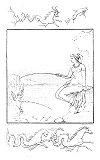 |
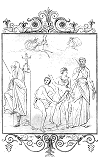 |
 |
Plate 42 |
Plate 46 |
Plate 49 |
Bonucci, who had every opportunity of obtaining
information, gives a long list of objects found in the house
of the poet. Some of them are too interesting to be
omitted.
Of gold, were found two necklaces and two bracelets, formed
of two lines of semiglobes, which have since been imitated by
the goldsmiths and jewellers of Naples.
Two armlets, formed like serpents, in many convolutions, and
a smaller one for a child.
Four ear-rings, each of two pearls, hanging as if from a
balance.
A ring of onyx with the head of a youth.
Two coins, one of Nero and one of Titus. These objects seemed
to have fallen from the dressing-case of a female who lived
in the upper story. They were not more than five feet below
the soil.
Thirty-nine silver coins, both consular and imperial ; a mass
of brass coins ; twenty-seven coins separate ; saucepans and
kitchen utensils of all sorts ; a vase for oil ; a bucket ; a
lamp for two lights, with the head and feet of a bull which
hung from the ceiling of a chamber ; a little tripod ; a
candelabrum ; screws belonging to the furniture.
Of iron, four hatchets ; a hammer ; a tripod ; a broken key ;
two hooks ; two heels for boots, with holes for the nails ;
locks, latches, and hinges.
Of glass, four decanters and three globular bottles. Of terra
cotta, fifty-six lamps and many other articles ; among them a
cup, with fine enamel or varnish. Six plates are said to have
been found in another place, with fine blue varnish.
A head of Hermes of giallo antico ; a quantity of corn
; many ropes carbonized ; a piece of soap, and three weights
of lead. In a house not far distant were found, in the month
of November, 1826, vases with olives still swimming in oil.
They retained their colour, and the oil burnt well. Also a
vase of caviare, or the eggs of tunny fish. Ashes had fallen
into air, and formed a sort of crust, which had preserved the
contents.
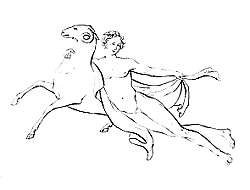
Vignette 18 - Commentary |
|
(1) This art of representing the effect of a picture upon a wall, instead of imitating nature itself, is applied, with considerable success, in the decoration of certain modern Italian habitations. The author has seen in the Palazzo Sannizzi, at Rieti, a room of magnificent dimensions, on entering which a visiter imagines himself in an apartment hung with green damask, and decorated with a profusion of splendid pictures. There are Madonnas and Holy Familles, landscapes, animals, and battle-pieces, which recal, at the moment, the names and works of the most distinguished artists. A further examination, on a nearer approach, shows that no one of the objects has any decided form or outline, or intelligible sign. Not only does the whole collection consist in the representation of pictures, but their seemingly gold frames are merely wooden mouldings roughly painted with ochre, most scantily touched, here and there, in the prominent parts, with gilding to represent the effect of catching lights. Behind each sham picture was nothing but the white wall, and the apparently rich silk hangings consist in a few narrow stripes of the stuff between the frames - yet the whole has a good effect. |

